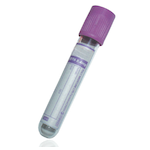Suitable Specimen Types
- EDTA Plasma
- Special Collection Procedures Apply
Specimen Transport
Send frozen to referral laboratory weekly
Sample Processing in Laboratory
Blood sample must reach the laboratory within 30 minutes (and preferably have been taken onto ice)
Sample Preparation
NOTE TIME WHEN SPECIMEN WAS TAKEN.
Centrifuge within 30 mins, using cold buckets.
Transfer plasma to a labelled plastic tube.
If visible haemolysis is present, discuss the suitability of the sample with the duty biochemist.
Turnaround Time
14 daysSample Stability
Store plasma immediately at -20oC
Adrenocorticotrophic Hormone (ACTH)
General Information
Adrenocorticotropic hormone (ACTH) is produced in the pituitary gland to stimulate secretion of cortisol by the adrenal glands. Normally, ACTH increases when cortisol is low and falls when cortisol is high. The concentration of ACTH varies greatly at different times of the day, with the highest amount at about 8 am and the lowest about midnight, therefore the sample will normally be collected first thing in the morning.
Secretion of ACTH may be increased by stress.
Some drugs and conditions can cause ACTH levels to rise, including amphetamines, insulin, levodopa, and metoclopramide.
Drugs that cause ACTH to fall include dexamethasone and other drugs that act like cortisol (including prednisone, hydrocortisone, prednisolone, and methylprednisolone), and megestrol acetate.
Ectopic tumours may secrete fragments or big ACTH which are biologically active but undetected by the assay.
Cross reactivity with synacthen is <= 1%
Patient Preparation
Ensure patient is not taking corticosteroids, synacthen and avoid undue stress. Please state time of collection. Lithium heparin interferes with the assay. Take blood into EDTA tubes and send to the lab immediately on ice.
Notes
To diagnose adrenal and pituitary diseases such as Cushing's syndrome, Cushing's disease, Addison's disease, adrenal tumors, and pituitary tumors; usually done as a diagnostic test once an abnormal cortisol level is detected.
Reference Range
7.2 - 63.3 ng/L (7-10am)Source of Reference Range
Provided by referral laboratorySpecifications
- EQA Scheme?: Yes
-
EQA Status:
Laboratory participates in the NEQAS scheme
